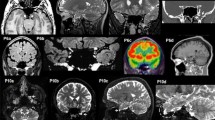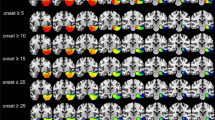Abstract
Visual object naming is an essential part of speech processing in the brain. Structurally it involves a dynamic interplay of nonverbal object representations and stored information about the form, function and meaning of objects. Naming deficits can rely both on dysfunctions in the visual identification of objects and dysfunctions in the semantic classification of visual object representations. Clinical and psychological studies show that the left temporal lobe incorporates a semantic processing network, supporting a discriminating operation mode. It is hypothesized that a network with these functional properties can serve the purpose of precise word finding.
Visual object naming tests are a standard part of neuropsychological test protocols for surgical epilepsy treatment. Preoperatively naming deficits are frequently found in patients with left temporal lobe epilepsy. Postoperatively a high risk of naming decline is associated with surgery in the speech dominant left temporal lobe. There is good empirical evidence for an interrelation between postoperative naming ability and the age of epilepsy onset. Stable naming performances are probably related to a deviant intrahemispheric speech representation as a result of early brain damage and/or chronic seizures.
Zusammenfassung
Die visuelle Objektbenennung ist ein konstruktiver Verarbeitungsprozess im Gehirn, bei dem externe Informationen sowie intern gespeichertes Wissen über Form- und Bedeutungsmerkmale von Objekten zusammengeführt werden. Klinische und kognitionspsychologische Studien zeigen eine spezifische Beteiligung des linken Temporallappens an der zielgerichteten sprachlichen Klassifikation von Objekten. Es wird vermutet, dass Benennstörungen bei linkstemporalen Schädigungen durch Fehlfunktionen in der wissensgesteuerten, semantischen Verarbeitung komplexer visueller Objektrepräsentationen resultieren.
Störungen der Objektbenennung stellen ein wichtiges Begleitsymptom bei Epilepsien im linken Temporallappen (LTE) dar. Neben präoperativen Defiziten, die primär mit der Lokalisation des epileptischen Fokus in der sprachdominanten Hemisphäre zusammenhängen, resultieren funktionelle Verschlechterungen vor allem durch linkstemporale epilepsiechirurgische Eingriffe. Risiken betreffen jedoch nicht alle Patienten gleichermaßen, sondern werden in besonderer Weise durch epilepsiespezifische Faktoren bestimmt.
Similar content being viewed by others
Literatur
Abernethy M, Coney J (1996) Semantic category priming in the left cerebral hemisphere. Neuropsychologia 34:339–350
Bartha L, Trinka E, Ortler M, Donnemiller E, Felber S, Bauer G, Benke T (2004) Linguistic deficits following left selective amygdalohippocampectomy: a prospective study. Epilepsy and Behavior 5:348–357
Bell BD, Davies KG, Hermann BP, Walters G (2000) Confrontation naming after anterior temporal lobectomy is related to age of acquisition of the object names. Neuropsychologia 38:83–92
Bell B, Hermann B, Seidenberg M, Davies K, Cariski D, Rosenbek J, Woodard A, Rutecki P, Bishop M (2002) Ipsilateral reorganization of language in early-onset left temporal lobe epilepsy. Epilepsy and Behavior 3:158–164
Bright P, Moss H, Tyler LK (2004) Unitary vs multiple semantics: PET studies of word and picture processing. Brain and Language 89:417–432
Büchel C, Price C, Friston K (1998) A multimodal language region in the ventral visual pathway. Nature 394:274–277
Bussey TJ, Saksida LM (2002) The organization of visual object representations: a connectionist model of effects of lesions in perirhinal cortex. European Journal of Neuroscience 15:355–364
Chao LL, Haxby JV, Martin A (1999) Attribute-based neural substrates in temporal cortex for perceiving and knowing about objects. Nature Neuroscience 2:919–913
Clusmann H, Schramm J, Kral T, Helmstaedter C, Ostertun B, Fimmers R, Haun D, Elger CE (2002) Prognostic factors and outcome after different types of resection for temporal lobe epilepsy. Journal of Neurosurgery 97:1131–1141
Coney J, Evans KD (2000) Hemispheric asymmetries in the resolution of lexical ambiguity. Neuropsychologia 38:272–282
Copland DA, Chenery HJ, Murdoch BE (2002) Hemispheric contributions to lexical ambiguity resolution: Evidence from individuals with complex language impairment following lefthemisphere lesions. Brain and Language 81:131–143
Davies KG, Maxwell RE, Beniak TE, Destafney E, Fiol ME (1995) Language function after temporal lobectomy without stimulation mapping of cortical function. Epilepsia 36:130–136
Davies KG, Bell BD, Bush AJ, Hermann BP, Dohan CD, Jaap AS (1998) Naming decline after left anterior temporal lobectomy correlates with pathological status of resected hippocampus. Epilepsia 39:407–419
Deacon D, Grose-Fifer J, Yang CM, Stanick V, Hewitt S, Dynowska A (2004) Evidence for a new conceptualization of semantic representation in the left and right cerebral hemispheres. Cortex 40:467–478
Devinsky O, Perrine K, Llinas R, Luciano DJ, Dogali M (1993) Anterior temporal language areas in patients with early onset of temporal lobe epilepsy. Annals of Neurology 34:727–732
Devinsky O, Perrine K, Hirsch J, McMullen W, Pacia S, Doyle W (2000) Relation of cortical language distribution and cognitive function in surgical epilepsy patients. Epilepsia 41:400–404
Federmeier KD, Kutas M (1999) Right words and left words: electrophysiological evidence for hemispheric differences in meaning processing. Cognitive Brain Research 8:373–392
Giovagnoli AR, Erbetta A, Villani F, Avanzini G (2005) Semantic memory in partial epilepsy: verbal and nonverbal deficits and neuroanatomical relationships. Neuropsychologia 43:1482–1492
Grill-Spector K, Kourtzi Z, Kanwisher N (2001) The lateral occipital complex and its role in object recognition. Vision Research 41:1409–1422
Grindrod CM, Baum SR (2005) Hemispheric contributions to lexical ambiguity resolution in a discourse context: Evidence from individuals with unilateral left and right hemisphere lesions. Brain and Cognition 57:70–83
Hermann BP, Wyler AR, Somes G, Clement L (1994) Dysnomia after left anterior temporal lobectomy without functional mapping: frequency and correlates. Neurosurgery 35:52–57
Hermann BP, Seidenberg M, Schoenfeld J, Peterson J, Leveroni C, Wyler AR (1996) Empirical techniques for determining the reliability, magnitude, and pattern of neuropsychological change after epilepsy surgery. Epilepsia 37:942–950
Hermann B, Davies K, Foley K, Bell B (1999) Visual confrontation naming outcome after standard left anterior temporal lobectomy with sparing versus resection of the superior temporal gyrus: A randomized prospective clinical trial. Epilepsia 40:1070–1076
Hermann BP, Perrine K, Chelune GJ, Barr W, Loring DW, Strauss E, Trenerry MR, Westerveld M (1999) Visual confrontation naming following left anterior temporal lobectomy: a comparison of surgical approaches. Neuropsychology 13:3–9
Ishai A, Ungerleider LG, Martin A, Schouten JL, Haxby JV (1999) Distributed representation of objects in the human ventral visual pathway. Proceedings of the National Academy of Sciences of the United States of America 96:9379–9384
Jones-Gotman M, Zatorre RJ, Olivier A, Andermann F, Cendes F, Staunton H, McMackin D, Siegel AM, Wieser, HG (1997) Learning and retention of words and designs following excision from medial or lateral temporal lobe structures. Neuropsychologia 35:963–973
Kanwisher N, Woods RP, Iacoboni M, Mazziotta JC (1997) A locus in human extrastriate cortex for visual shape analysis. Journal of Cognitive Neuroscience 9:133–142
Khateb A, Michel CM, Pegna AJ, Thut G, Landis T, Annoni JM (2001) The time course of semantic category processing in the cerebral hemispheres: an electrophysiological study. Cognitive Brain Research 10:251–264
Koivisto M, Laine M (1999) Strategies of semantic categorization in the cerebral hemispheres. Brain and Language 66:341–357
Koivisto M, Hämäläinen H (2002) Hemispheric semantic priming in the single word presentation task. Neuropsychologia 40:978–985
Kourtzi Z, Kanwisher N (2000) Cortical regions involved in perceiving object shape. The Journal of Neuroscience 20:3310–3318
Krauss GL, Fisher R, Plate C, Hart J, Uematsu S, Gordon B, Lesser RP (1996) Cognitive effects of resecting basal temporal language areas. Epilepsia 37:476–483
Langfitt JT, Rausch R (1996) Wordfinding deficits persist after left anterotemporal lobectomy. Archives of Neurology 53:72–76
Liégeois F, Connelly A, Cross JH, Boyd SG, Gadian DG, Vargha-Khadem F, Baldeweg T (2004) Language reorganization in children with early onset lesions of the left hemisphere: an fMRI study. Brain 127:1229–1236
Liu Z, Kersten D, Knill DC (1999) Dissociating stimulus information from internal representation—a case study in object recognition. Vision Research 39:603–612
Malach R, Reppas JB, Benson RR, Kwong KK, Jiang H, Kennedy WA, Ledden PJ, Brady TJ, Rosen BR, Tootell RBH (1995) Object-related activity revealed by functional magnetic resonance imaging in human occipital cortex. Proceedings of the National Academy of Sciences of the United States of America 92:8135–8139
Mayeux R, Brandt J, Rosen J, Benson F (1980) Interictal memory and language impairment in temporal lobe epilepsy. Neurology 30:120–125
Müller RA, Behen ME, Rothermel RD, Muzik O, Chakraborty PK, ChuganiHT (1999) Brain organization for language in children, adolescents, and adults with left hemisphere lesion: a PET study. Progress in Neuro-Psychopharmacology & Biological Psychiatry 23:657–668
Murray EA, Bussey TJ (1999) Perceptual–mnemonic functions of the perirhinal cortex. Trends in Cognitive Sciences 3:142–151
N’Kaoua B, Lespinet V, Barsse A, Rougier A, Claverie B (2001) Exploration of hemispheric specialization and lexico-semantic processing in unilateral temporal lobe epilepsy with verbal fluency tasks. Neuropsychologia 39:635–642
Noppeney U, Price CJ (2002) Retrieval of visual, auditory, and abstract semantics. Neuroimage 15:917–926
Ogden-Epker M, Cullum CM (2001) Quantitative and qualitative interpretation of neuropsychological data in the assessment of temporal lobectomy candidates. The Clinical Neuropsychologist 15:183–195
Op de Beeck H, Béatse E, Wagemans J, Sunaert S, Van Hecke P (2000) The representation of shape in the context of visual object categorization tasks. Neuroimage 12:28–40
Pegna AJ, Qayoom Z, Gericke CA, Landis T, Seeck M (1998) Comprehensive postictal neuropsychology improves focus localization in epilepsy. European Neurology 40:207–211
Querné L, Eustache F, Faure S (2000) Interhemispheric inhibition, intrahemispheric Activation, and lexical capacities of the right hemisphere: A tachistoscopic, divided visual-field study in normal subjects. Brain and Language 74:171–190
Sawrie SM, Chelune GJ, Naugle RI, Luders HO (1996) Empirical methods for assessing meaningful neuropsychological change following epilepsy surgery. Journal of the International Neuropsychological Society 2:556–564
Saykin AJ, Stafiniak P, Robinson LJ, Flannery KA, Gur RC, O’Connor MJ, Sperling MR (1995) Language before and after temporal lobectomy: specifity of acute changes and relation to early risk factors. Epilepsia 36:1071–1077
Schefft BK, Testa SM, Dulay MF, Privitera MD, Yeh HS (2003) Preoperative assessment of confrontation naming ability and interictal paraphasia production in unilateral temporal lobe epilepsy. Epilepsy & Behavior 4:161–168
Schendan HE, Kutas M (2002) Neurophysiological evidence for two processing times for visual object identification. Neuropsychologia 40:931–945
Schwartz TH, Devinsky O, Doyle W, Perrine K (1998) Preoperative predictors of anterior temporal language areas. Journal of Neurosurgery 89:962–970
Springer JA, Binder JR, Hammeke TA, Swanson SJ, Frost JA, Bellgowan PSF, Brewer CC, Perry HM, Morris GL, Mueller WM (1999) Language dominance in neurologically normal and epilepsy subjects—a functional MRI study. Brain 122:2033–2045
Stafiniak P, Saykin AJ, Sperling MR, Kester DB, Robinson LJ, O’Connor MJ, Gur RC (1990) Acute naming deficits following dominant temporal lobectomy: Prediction by age at 1st risk for seizures. Neurology 40:1509–1512
Taylor KI, Brugger P, Weniger D, Regard, M (1999) Qualitative hemispheric differences in semantic category matching. Brain and Language 70:119–131
Tyler LK, Stamatakis EA, Bright P, Acres K, Abdallah S, Rodd JM, Moss HE (2004) Processing objects at different levels of specificity. Journal of Cognitive Neuroscience 16:351–362
Vandenberghe R, Price C, Wise R, Josephs O, Frackowiak RSJ (1996) Functional anatomy of a common semantic system for words and pictures. Nature 383:254–256
Zahn R, Huber W, Drews E, Erberich S, Krings T, Willmes K, Schwarz M (2000) Hemispheric lateralization at different levels of human auditory word processing: a functional magnetic resonance imaging study. Neuroscience Letters 287:195–198
Author information
Authors and Affiliations
Corresponding author
Rights and permissions
About this article
Cite this article
Schwarz, M., Pauli, E. Visuelle Objektbenennungsstörungen in der neuropsychologischen Diagnostik und chirurgischen Therapie bei Temporallappenepilepsie. Z. Epileptol. 19, 258–264 (2006). https://doi.org/10.1007/s10309-006-0221-1
Received:
Accepted:
Issue Date:
DOI: https://doi.org/10.1007/s10309-006-0221-1




